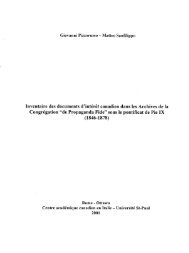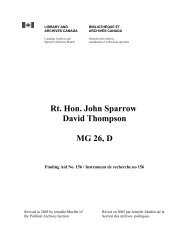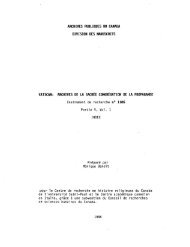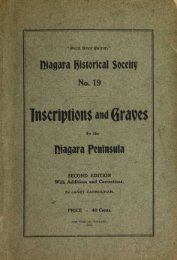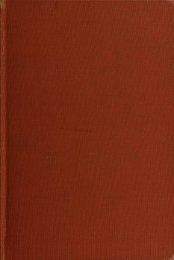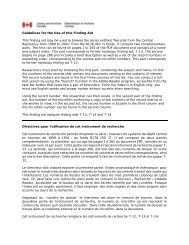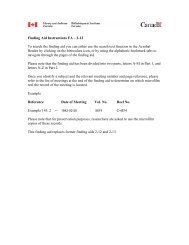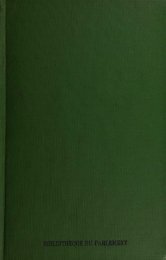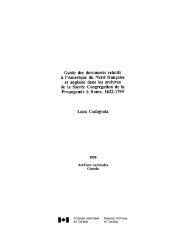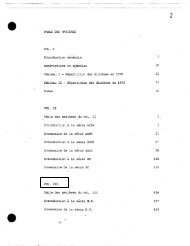Guide to Documents Relating to French and British North America in ...
Guide to Documents Relating to French and British North America in ...
Guide to Documents Relating to French and British North America in ...
Create successful ePaper yourself
Turn your PDF publications into a flip-book with our unique Google optimized e-Paper software.
past four years with the consent of his <strong>French</strong> ord<strong>in</strong>ary, the bishop of Sa<strong>in</strong>t-Malo, Fran~ois de Ville-<br />
Montee. 2S Propag<strong>and</strong>a <strong>to</strong>ok every opportunity <strong>to</strong> make it clear that whoever wanted <strong>to</strong> become an<br />
apos<strong>to</strong>lic missionary <strong>and</strong> operate <strong>in</strong> mission terri<strong>to</strong>ries had <strong>to</strong> ask the Congregation for special faculties.<br />
These varied accord<strong>in</strong>g <strong>to</strong> the needs <strong>and</strong> the position of the petitioners, <strong>and</strong> had <strong>to</strong> be renewed<br />
periodically <strong>in</strong> order <strong>to</strong> ma<strong>in</strong>ta<strong>in</strong> a closer relationship between Propag<strong>and</strong>a officials <strong>and</strong> their<br />
subord<strong>in</strong>ates around the world. 26<br />
Missions had <strong>to</strong> be formalized as soon as possible. In the early stages of missionary activities,<br />
a prefect apos<strong>to</strong>lic was appo<strong>in</strong>ted. He was responsible <strong>to</strong> Propag<strong>and</strong>a <strong>and</strong> could partially communicate<br />
his faculties <strong>to</strong> his missionaries. Missions might be small, but the organizational structure was <strong>to</strong> be<br />
applied <strong>to</strong> all of them. In the second half of the eighteenth century, a small mission such as Sa<strong>in</strong>t-<br />
Pierre <strong>and</strong> Miquelon consisted of a prefect apos<strong>to</strong>lic (<strong>in</strong> Sa<strong>in</strong>t-Pierre) <strong>and</strong> a s<strong>in</strong>gle missionary (<strong>in</strong><br />
Miquelon).27 Propag<strong>and</strong>a always corresponded with <strong>in</strong>dividual missionaries operat<strong>in</strong>g <strong>in</strong> the New World,<br />
although it was cautious never <strong>to</strong> bypass the appo<strong>in</strong>ted superiors <strong>in</strong> the colonies. Those who wrote <strong>to</strong><br />
Propag<strong>and</strong>a were unsophisticated priests who simply did not know whether the l<strong>and</strong> <strong>in</strong> which they<br />
found themselves was dependent on any superior, missionaries so far from established hierarchies that<br />
they found it easier <strong>to</strong> correspond with Rome than with Quebec or Baltimore, rebel priests at war<br />
with their superiors, idealists envisag<strong>in</strong>g gr<strong>and</strong> schemes for the conversion of the <strong>America</strong>n savages,<br />
or simply European priests who longed <strong>to</strong> be exposed <strong>to</strong> the v<strong>in</strong>eyards of the New World. 28<br />
In the mid-seventeenth century, Canada became important enough <strong>to</strong> require a more efficient<br />
hierarchic structure. Until then, for most practical purposes, the Jesuits had run the church <strong>in</strong> the<br />
colony. (As we shall see, Propag<strong>and</strong>a had almost no power over them). In 1658 Laval was appo<strong>in</strong>ted<br />
vicar apos<strong>to</strong>lic <strong>in</strong> Canada. A vicar apos<strong>to</strong>lic was, <strong>in</strong> fact, a bishop abroad (<strong>in</strong> partibus <strong>in</strong>fidelium). He<br />
had the spiritual powers of a bishop, but depended on Propag<strong>and</strong>a. As soon as European diplomacy<br />
allowed it, Laval was appo<strong>in</strong>ted full bishop of Quebec. 29 Propag<strong>and</strong>a corresponded directly with Laval<br />
<strong>and</strong> his successors. Laval, <strong>in</strong> particular, sent yearly reports on the state of religion <strong>in</strong> his diocese. Later,<br />
Bishop Jean-Olivier Bri<strong>and</strong> (the first bishop after the English Conquest of 1760) appo<strong>in</strong>ted a vicar<br />
general <strong>in</strong> Paris, who acted as his liaison with Rome <strong>and</strong> Propag<strong>and</strong>a. The three successive vicars<br />
general <strong>in</strong> Paris (Pierre de La Rue, better known as Abbe de L'Isle-Dieu, appo<strong>in</strong>ted before the<br />
Conquest, 1734-1777; Fran~ois Sorbier de Villars, 1777-1788; <strong>and</strong> Mart<strong>in</strong> Hody, 1789-1792) forwarded<br />
<strong>and</strong> often filtered an enormous amount of correspondence com<strong>in</strong>g from <strong>North</strong> <strong>America</strong>. De La Rue was<br />
often assisted by Joseph-Marie de La Come de Chaptes, dean of the Chapter of Quebec (1762-1779).<br />
When the <strong>French</strong> Revolution disrupted the cus<strong>to</strong>mary networks, the correspondence between Canada<br />
<strong>and</strong> Rome went via Lisbon -- where the Quebec merchant Francis Morrogh acted as a practical contact<br />
-- or was entrusted <strong>to</strong> priests travell<strong>in</strong>g from Rome <strong>to</strong> Engl<strong>and</strong> via Venice <strong>and</strong> Germany. Of course,<br />
after the Conquest, Canada became an English possession, <strong>and</strong> a number of matters were dealt with<br />
<strong>in</strong> London rather than <strong>in</strong> Paris. Thomas Hussey was then appo<strong>in</strong>ted vicar general of the bishop of<br />
Quebec <strong>in</strong> London (1784-1788). Like his <strong>French</strong> colleagues, Hussey <strong>to</strong>o had a volum<strong>in</strong>ous<br />
correspondence with Propag<strong>and</strong>a.30<br />
After the <strong>America</strong>n War of Independence, Propag<strong>and</strong>a tried <strong>to</strong> organize the <strong>America</strong>n clergy<br />
accord<strong>in</strong>g <strong>to</strong> the system that had been applied <strong>to</strong> Canada. (Before the <strong>America</strong>n Revolution, there were<br />
only Jesuits <strong>in</strong> the <strong>British</strong> cont<strong>in</strong>ental colonies, <strong>and</strong> the vicar apos<strong>to</strong>lic <strong>in</strong> the London district enjoyed<br />
<strong>to</strong>ken jurisdiction over them.) At first, a proposal was put forward <strong>to</strong> establish a vicar apos<strong>to</strong>lic <strong>in</strong><br />
Baltimore or Philadelphia. When Benjam<strong>in</strong> Frankl<strong>in</strong> unexpectedly made it clear that the <strong>America</strong>n<br />
Congress actually preferred an <strong>America</strong>n bishop <strong>to</strong> a foreign vicar apos<strong>to</strong>lic, John Carroll was first<br />
appo<strong>in</strong>ted prefect apos<strong>to</strong>lic of the missions <strong>in</strong> the United Prov<strong>in</strong>ces of <strong>America</strong> (1784), <strong>and</strong> then full<br />
bishop of Baltimore (1789), thus becom<strong>in</strong>g the second Catholic bishop <strong>in</strong> Anglo-<strong>America</strong>. Like his<br />
colleague <strong>in</strong> Quebec, Carroll corresponded directly with Propag<strong>and</strong>a, but often used Hussey <strong>in</strong> London<br />
<strong>to</strong> keep up correspondence with Rome. 3l<br />
6




